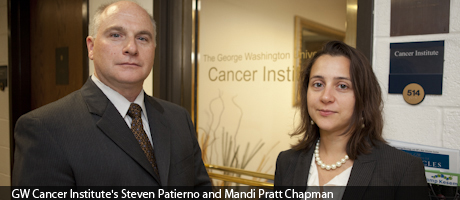GW’s Office of Cancer Survivorship, in partnership with the American Cancer Society, recently won a $4.25 million grant from the Centers for Disease Control and Prevention—and it put the grant application together in record time.
When a colleague from the D.C. Department of Health brought the CDC’s RFP—request for proposal—to Mandi Pratt Chapman’s attention, there was no time to lose. It was due in fewer than three weeks.
She discussed the project with Steven Patierno, executive director of the GW Cancer Institute, and decided to approach a colleague at the American Cancer Society with a plan for the two institutions to collaborate. By the time the society approved the project, the deadline for the proposal was less than a week away.
Ms. Chapman, director of the institute’s Office of Cancer Survivorship, spent the weekend researching the proposal, which launched a national competition to host the CDC’s National Cancer Survivorship Resource Center. She and several colleagues at the society then wrote like mad for four days.
Ms. Chapman and her colleagues completed the proposal at an accelerated pace—something which required intense communication and collaboration between two organizations.
“We were very sure that we submitted a strong proposal,” says Ms. Chapman.
The GW Cancer Institute staff felt that the grant could build on the momentum generated by its recent success in obtaining three major grants: from the pharmaceutical company Pfizer for the Center for the Advancement of Cancer Survivorship, Navigation and Policy, from the D.C. Cancer Consortium for its city-wide Patient Navigation Network and for its Cancer Survivorship Center.
“Collaborating with the American Cancer Society at a national level to assess and address the critical needs of 12 million cancer survivors in the U.S. today, and to support those survivors through a model of longitudinal navigation that originated here at the Cancer Institute—this is huge for GW,” says Ms. Chapman.
Patient navigation, an approach to health care that tries to remove barriers to accessing health care and screenings particularly for lower income patients, has spread widely in the past decade, according to Dr. Patierno.
“You’d be hard pressed to find a new concept in any kind of medical or health service area that has taken root and integrated itself into health care as quickly as patient navigation,” he says.
“You can’t ask a woman in Ward 8 to go get a mammogram when she can’t get across the Anacostia River without taking five bus rides and two cab rides and losing half a day of her wage account salary,” says Dr. Patierno. “Patient navigators find creative ways to overcome those barriers.”
From its foundation in 2003, the Cancer Institute has adopted caring for the community and eliminating cancer disparities as a central component of its mission. “We’re in a cancer disaster area,” Dr. Patierno says of the District.
Dr. Patierno and colleagues at the institute revolutionized approaches to cancer treatment by expanding the scope of patient navigation. Whereas navigation had previously begun at the diagnosis stage and ended at the point where treatment began, GW experts decided it ought to begin well before diagnosis (with screenings) and carry on even after treatment ended.
“This new grant is evidence of GW’s position on the forefront of the field of patient navigation and survivorship,” says Ms. Chapman. “It also builds on a rich history of the Cancer Institute’s partnership with the American Cancer Society. We could not be more thrilled to be partnering with the society on this critical project.”


